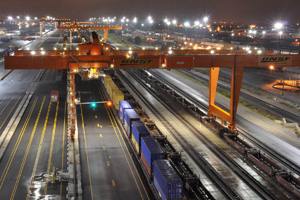BNSF Casts Doubt on Future of Southern California Intermodal Project

BNSF Railway cast doubt on the future of its $500 million intermodal terminal facility in Southern California, saying “it is not clear whether or how the project could be built” in light of a recent court decision.
The statement from Steve Bobb, executive vice president, was issued nine days after a California court ruled that the project required further environmental review to assess the effects on residents in Long Beach, California, who filed suit against the project three years ago. The project known as the Southern California International Gateway has been in development for a decade, and had proceeded as far as environmental approvals from the city and Port of Los Angeles.
The site of the 183-acre terminal proposal is on the Los Angeles border with Long Beach, the two cities that are home to the two largest U.S. ports. BNSF proposed the project to build a terminal less than five miles from both ports’ docks, shortening the truck trip from the current 24-mile one-way run to a BNSF facility that is at capacity. The Fort Worth, Texas-based railroad continues to be the largest truck/rail freight carrier, accounting for about 30% of all U.S. intermodal freight.
“After a thorough review of the ruling, BNSF is troubled by what the decision represents and uncertain whether moving forward with the project is feasible at this time,” Bobb said. “We will confer with Port of Los Angeles officials, but it is not clear whether or how the project can continue under the framework set by the decision.”
The railroad didn’t announce when it would meet with Los Angeles officials, and didn’t provide that information when requested by TT.
BNSF termed the court ruling “a major loss for both ports, the local community and the region. The ports miss the opportunity to have a green, efficient facility that serves their customers and bolsters their competitiveness. The community and broader region won’t benefit from the traffic reductions, air quality improvements and good jobs SCIG would have brought. It sets a chilling precedent for not only the rail industry, but the entire goods movement sector, which employs more than a million Californians.”
Residents of West Long Beach argued in the suit that the new terminal’s location would worsen existing pollution, traffic and health issues.
The court ruled that the environmental review wasn’t thorough enough, even though it took eight years. The environmental reviews themselves totaled more than 5,000 pages and generated more than 200,000 pages of commentary.




